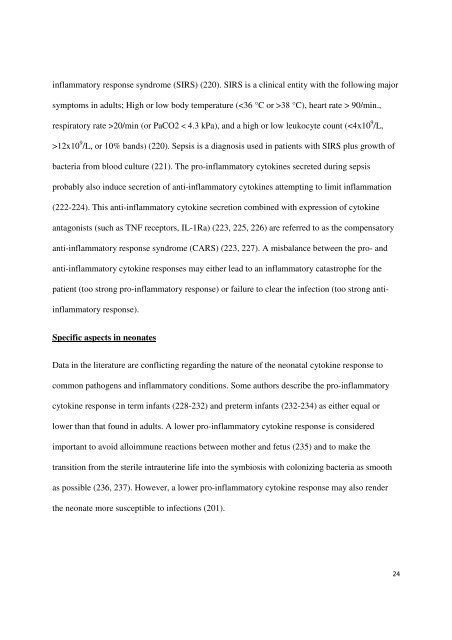Staphylococcus epidermidis - virulence factors and innate ... - Munin
Staphylococcus epidermidis - virulence factors and innate ... - Munin
Staphylococcus epidermidis - virulence factors and innate ... - Munin
Create successful ePaper yourself
Turn your PDF publications into a flip-book with our unique Google optimized e-Paper software.
inflammatory response syndrome (SIRS) (220). SIRS is a clinical entity with the following major<br />
symptoms in adults; High or low body temperature (38 °C), heart rate > 90/min.,<br />
respiratory rate >20/min (or PaCO2 < 4.3 kPa), <strong>and</strong> a high or low leukocyte count (12x10 9 /L, or 10% b<strong>and</strong>s) (220). Sepsis is a diagnosis used in patients with SIRS plus growth of<br />
bacteria from blood culture (221). The pro-inflammatory cytokines secreted during sepsis<br />
probably also induce secretion of anti-inflammatory cytokines attempting to limit inflammation<br />
(222-224). This anti-inflammatory cytokine secretion combined with expression of cytokine<br />
antagonists (such as TNF receptors, IL-1Ra) (223, 225, 226) are referred to as the compensatory<br />
anti-inflammatory response syndrome (CARS) (223, 227). A misbalance between the pro- <strong>and</strong><br />
anti-inflammatory cytokine responses may either lead to an inflammatory catastrophe for the<br />
patient (too strong pro-inflammatory response) or failure to clear the infection (too strong antiinflammatory<br />
response).<br />
Specific aspects in neonates<br />
Data in the literature are conflicting regarding the nature of the neonatal cytokine response to<br />
common pathogens <strong>and</strong> inflammatory conditions. Some authors describe the pro-inflammatory<br />
cytokine response in term infants (228-232) <strong>and</strong> preterm infants (232-234) as either equal or<br />
lower than that found in adults. A lower pro-inflammatory cytokine response is considered<br />
important to avoid alloimmune reactions between mother <strong>and</strong> fetus (235) <strong>and</strong> to make the<br />
transition from the sterile intrauterine life into the symbiosis with colonizing bacteria as smooth<br />
as possible (236, 237). However, a lower pro-inflammatory cytokine response may also render<br />
the neonate more susceptible to infections (201).<br />
24
















